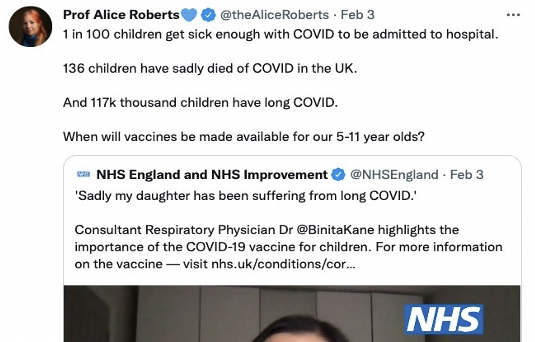Earlier this month, NHS England tweeted out a video to its half million followers to try to promote the Covid vaccine among children. The video cited a series of worrying, but inaccurate, statistics about the risks that Covid apparently represents to children; one in a hundred children will get sick enough with Covid to be admitted to hospital; 136 children in the UK have died of Covid-19, and 117,000 children are suffering from long covid.
The response duly ‘went viral’, attracting re-tweets from some of the biggest public health influencers online, who shared the report with their hundreds of thousands of followers, endorsing it as “an important message”, “an excellent piece”, “a great video”, and using it to lobby JCVI “when will be able to protect our children?”, and alerting people to “the misinformation out there”, no doubt with good intentions.

But when I watched the video I was left quite concerned and confused. As both a parent and scientist who has been involved in research on symptom duration and severity of covid in children, the cited statistics didn’t make sense to me. The idea that 1% of children with Covid are hospitalised for it didn’t pass the ‘sniff test’. I know how contentious the debates about prolonged symptoms after covid infection have been, and likewise the challenges of estimating covid mortality among children. So the idea of broadcasting confident numbers on this seemed odd, especially from NHS England.
What’s more, the powerful — and important — sharing of a story about “long covid” in a 11-year-old seemed at odds with current UK vaccination guidance, which does not currently advise vaccination of this age group. As a parent of an 8- and 6-year-old, I didn’t know what I was supposed to do with this ‘information’. Even more so when I was aware that there is not currently evidence to show that vaccination prevents “long Covid” in children.
What was even more surprising to me was the reaction from both NHS England and many commentators when I raised these points on Twitter and with NHS England directly. I previously worked in government, where every statistic that made it into official comms or a Ministerial speech came with a ‘method note’ to explain it if asked. Yet there was a deafening silence from @NHSEngland when I, and others, asked.
Several people agreed with me, sharing their working for why these numbers are at best long outdated, may be orders of magnitude out, and risk undermining confidence in vaccine communications and uptake.

 Main Edition
Main Edition US
US FR
FR






Join the discussion
Join like minded readers that support our journalism by becoming a paid subscriber
To join the discussion in the comments, become a paid subscriber.
Join like minded readers that support our journalism, read unlimited articles and enjoy other subscriber-only benefits.
SubscribeWell done on calling this out. There is no such thing as a ‘noble lie’ or a benevolent manipulation. The idea that you can use this kind of dubious messaging so long as it gets the desired end just screams contempt for the average citizen and will ultimately undermine trust.
Maybe NHS England should reread the boy who cried wolf.
More propaganda from the NHS. Are we in the UK or China?
The public have now been told a thousand sensational lies over the last two years, with the consequence that they genuinely believe they are going to die, or their children are going to die, and so on. It’s going to take decades for the dimwits who terrified them needlessly to earn back the trust they lost, and even then they won’t deserve it.
“136 children have sadly died of Covid in the UK.”
Is this true? Or is this the conflating of any death of a person with Covid as opposed to from Covid? I vaguely remember hearing parents of a child with brain cancer–who died in hospital–protest that the medical boffins were saying that he died from Covid without mentioning his brain cancer.
More disgusting propaganda from the NHS, and shame on the so-called experts who joined the herd in re-tweeting this tosh. Bravo to Twitter for taking this propaganda down immediately, as a violation of the terms of service!
Oh,wait, they didn’t….
Not true according to the ONS.
A tangible example of misinformation from Official Sources being used to promote the message THEY want. This type of behaviour is happening more and more frequently undermining confidence in our public servants.
Trust may be an out of date and maligned concept but we lose it at our peril.
It may just be that we are increasingly being served by incompetents. Over promoted and lacking in experience.
Overpromoted, inexperienced incompetents? Perhaps we need to resurrect the old adage ‘lions led by donkeys’? (an absolute insult to the poor much maligned beasts, to be sure). Or Is3:4?
I don’t get this at all. “. . .we contacted NHSE&I and it acknowledged that the data were historic and had methodological shortcomings.” But isn’t the 1% hospitalisation statistic just blatantly false and isn’t that very different from methodological shortcomings? Has NHS&I explained at all?
More importantly, will now NHSE&I tweet that their numbers were wrong?
I think taking the video down really falls short, they should apologise at least.
Joseph Go*bbels , the NHS has surpassed thee!*
(* Apologies to Justinian I.)
Didn’t pass the ‘sniff test’. As with nearly all of the messaging we have had from msm ( main stream maniacs) over the last two years. Has the statistics regulator been asleep most of this time ?
The only surprise is that it took them only 4 days to take it down.
I bet that video (which I never saw) is making its way to Scotland and Wales.
And now parents are uncertain about MMR vaccination ( which almost certainly is a good thing ) because they no longer trust the NHS to tell them the truth about anything. Great work, guys!
136 children have sadly died OF Covid???
Recent ONS response to FOI application. Question posed was:
‘What was the number of deaths where COVID-19 was the only cause mentioned on the death certificate, 1 February 2020 to 31 December 2021, by sex and age group, England and Wales’.
Answer; fewer than 7000.
https://www.ons.gov.uk/aboutus/transparencyandgovernance/freedomofinformationfoi/covid19deathsandautopsiesfeb2020todec2021
About the same number who died following accidents at home in 2021. Although that was for a 12 month period, while the Covid deaths are for a 23 month period.
Note also that only 3 people under 20 have died from Covid alone.
Perhaps our very own UnHerd NHS expert:-
Dr Elaine Giedrys-Leeper would care to comment?
Who?
A vociferous UnHerd commentator on the NHS and its campaign of national hysteria & panic. She was ‘in action’ yesterday on the Mask controversy.
Accordingly to my admittedly rough calculations (necessary because it’s not getting reported) the UK generally spends around £30,000 to save a year of life – if the condition is covid though, the spend has been £300,000 per year of life saved. This is just one of several major costs (medical, financial, social, psychological & political) from the covid measures that have been under-reported, to put it mildly, by otherwise responsible media. Creating a vacuum into which the lunatic fringe has flooded, which in turn serves to convince the over-reactors of the nobility of their cause….
Great job!!!
Sadly, this kind of egregious behaviour by those who rule over us is no longer a surprise. As with all such behaviour, it is very short-sighted because if they’ve lied to us once why would be ever believe them again?